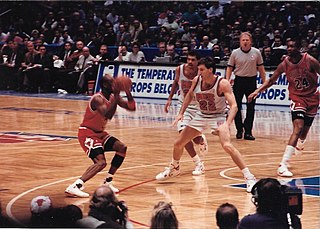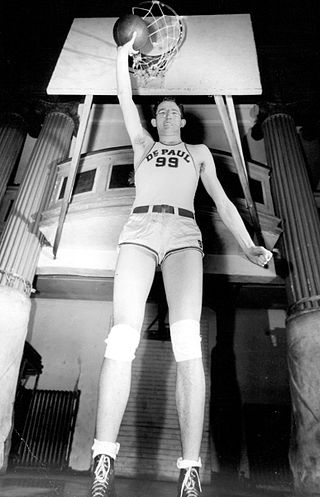
Basketball is a team sport in which two teams, most commonly of five players each, opposing one another on a rectangular court, compete with the primary objective of shooting a basketball through the defender's hoop, while preventing the opposing team from shooting through their own hoop. A field goal is worth two points, unless made from behind the three-point line, when it is worth three. After a foul, timed play stops and the player fouled or designated to shoot a technical foul is given one, two or three one-point free throws. The team with the most points at the end of the game wins, but if regulation play expires with the score tied, an additional period of play (overtime) is mandated.

A slam dunk, also simply known as dunk, is a type of basketball shot that is performed when a player jumps in the air, controls the ball above the horizontal plane of the rim, and scores by shoving the ball directly through the basket with one or both hands. It is a type of field goal that is worth two points. Such a shot was known as a "dunk shot" until the term "slam dunk" was coined by former Los Angeles Lakers announcer Chick Hearn.

George Lawrence Mikan Jr., nicknamed "Mr. Basketball", was an American professional basketball player for the Chicago American Gears of the National Basketball League (NBL) and the Minneapolis Lakers of the NBL, the Basketball Association of America (BAA) and the National Basketball Association (NBA). Invariably playing with thick, round spectacles, the 6 ft 10 in (2.08 m), 245 lb (111 kg) Mikan was one of the pioneers of professional basketball. Through his size and play, he redefined basketball as a game dominated in his day by "big men". His prolific rebounding, shot blocking, and ability to shoot over smaller defenders with his ambidextrous hook shot all helped to change the game. He also utilized the underhanded free-throw shooting technique long before Rick Barry made it his signature shot.

In basketball, the basketball court is the playing surface, consisting of a rectangular floor, with baskets at each end. Indoor basketball courts are almost always made of polished wood, usually maple, with 3.048 meters (10 ft)-high rims on each basket. Outdoor surfaces are generally made from standard paving materials such as concrete or asphalt. International competitions may use glass basketball courts.
In basketball, a technical foul is any infraction of the rules penalized as a foul which does not involve physical contact during the course of play between opposing players on the court, or is a foul by a non-player. The most common technical foul is for unsportsmanlike conduct. Technical fouls can be assessed against players, bench personnel, the entire team, or even the crowd. These fouls, and their penalties, are more serious than a personal foul, but not necessarily as serious as a flagrant foul.

A shot clock is a countdown timer used in a variety of games and sports, indicating a set amount of time that a team may possess the object of play before attempting to score a goal. Shot clocks are used in several sports including basketball, water polo, canoe polo, lacrosse, poker, ringette, korfball, tennis, ten-pin bowling, and various cue sports. It is analogous with the play clock used in American and Canadian football, and the pitch clock used in baseball. This article deals chiefly with the shot clock used in basketball.

The rules of basketball are the rules and regulations that govern the play, officiating, equipment and procedures of basketball. While many of the basic rules are uniform throughout the world, variations do exist. Most leagues or governing bodies in North America, the most important of which are the National Basketball Association and NCAA, formulate their own rules. In addition, the Technical Commission of the International Basketball Federation (FIBA) determines rules for international play; most leagues outside North America use the complete FIBA ruleset.

In basketball, a block or blocked shot occurs when a defensive player legally deflects a field goal attempt from an offensive player to prevent a score. The defender is not allowed to make contact with the offensive player's hand or a foul is called. In order to be legal, the block must occur while the shot is traveling upward or at its apex. A deflected field goal that is made does not count as a blocked shot and simply counts as a successful field goal attempt for shooter plus the points awarded to the shooting team. For the shooter, a blocked shot is counted as a missed field goal attempt. Also, on a shooting foul, a blocked shot cannot be awarded or counted, even if the player who deflected the field goal attempt is different from the player who committed the foul. If the ball is heading downward when the defender hits it, it is ruled as goaltending and counts as a made basket. Goaltending is also called if the block is made after the ball bounces on the backboard.
In basketball, an illegal dribble occurs when a player ends their dribble by catching or causing the ball to come to rest in one or both hands and then dribbles it again with one hand or when a player touches it before the ball hits the ground. The dribble also ends when the dribbler palms/carries the ball by allowing it to come to rest in one or both hands. This is a palming/carrying the ball violation if the player continues with another dribble.
In basketball, traveling is a violation of the rules of basketball in which a player takes more than a predefined number of steps. Taking more steps without dribbling than this limit will result in a turnover and possession of the ball for the other team.

This glossary of basketball terms is a list of definitions of terms used in the game of basketball. Like any other major sport, basketball features its own extensive vocabulary of unique words and phrases used by players, coaches, sports journalists, commentators, and fans.

In basketball, a foul is an infraction of the rules more serious than a violation. Most fouls occur as a result of illegal personal contact with an opponent and/or unsportsmanlike behavior. Fouls can result in one or more of the following penalties:
In basketball, the five-second rule, or five-second violation, is a rule that helps promote continuous play. There are multiple situations where a five-second violation may occur.

The key, officially referred to as the free throw lane by the National Basketball Association (NBA), the National Collegiate Athletic Association (NCAA), the National Association of Intercollegiate Athletics (NAIA), and the National Federation of State High School Associations (NFHS), and the restricted area by the International Basketball Federation (FIBA), is a marked area on a basketball court surrounding the basket, where much of the game's action takes place.
In basketball, basket interference is the violation of (a) touching the ball or any part of the basket while the ball is on the rim of the basket, (b) touching the ball when it is entirely within the cylinder extending upwards from the rim, (c) reaching up through the basket from below and touching the ball, whether it is inside or outside the cylinder, or (d) pulling down on the rim of the basket so that it contacts the ball before returning to its original position, or during a shot attempt. How the ball gets into the cylinder or onto the basket is irrelevant under high school and NCAA rules; e.g., a pass touched within the cylinder is basket interference, even though such a play may not score a goal. This similar play under (W)NBA rules would not be basket interference.

A breakaway rim is a basketball rim that contains a hinge and a spring at the point where it attaches to the backboard so that it can bend downward when a player dunks a basketball, and then quickly snaps back into a horizontal position when the player releases it. It allows players to dunk the ball without shattering the backboard, and it reduces the possibility of wrist injuries. Breakaway rims were invented in the mid-1970s and are now an essential element of high-level basketball.
The 1957–58 NCAA University Division men's basketball season began in December 1957, progressed through the regular season and conference tournaments, and concluded with the 1958 NCAA University Division basketball tournament championship game on March 22, 1958, at Freedom Hall in Louisville, Kentucky. The Kentucky Wildcats won their fourth NCAA national championship with an 84–72 victory over the Seattle Chieftains.
Basketball is a ball game and team sport in which two teams of five players try to score points by throwing or "shooting" a ball through the top of a basketball hoop while following a set of rules. Since being developed by James Naismith as a non-contact game that almost anyone can play, basketball has undergone many different rule variations, eventually evolving into the NBA-style game known today. Basketball is one of the most popular and widely viewed sports in the world.
Basketball is a team sport in which two teams of five players try to score points by throwing or "shooting" a ball through the top of a basketball hoop while following a set of rules. Basketball is one of the most popular and widely viewed sports in the world.
The 1944–45 NCAA men's basketball season began in December 1944, progressed through the regular season and conference tournaments, and concluded with the 1945 NCAA basketball tournament championship game on March 27, 1945, at Madison Square Garden in New York, New York. The Oklahoma A&M Aggies won their first NCAA national championship with a 49–45 victory over the NYU Violets.











